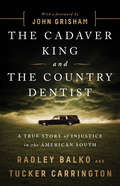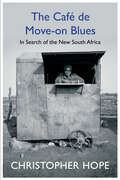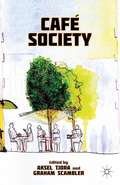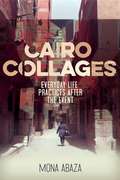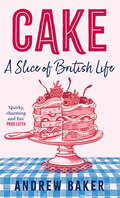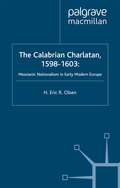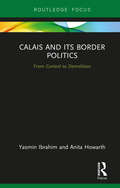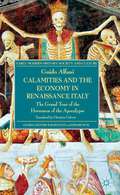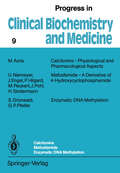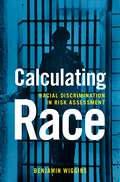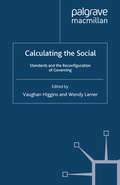- Table View
- List View
CACHE Technical Level 3 Extended Diploma in Health and Social Care (PDF)
by Maria Ferreiro Peteiro Elizabeth Rasheed Linda Wyatt Pete WedlakeMaster the essay-writing skills and concepts required to succeed in the Level 3 Extended Diploma with this CACHE-endorsed textbook.
The Cadaver King and the Country Dentist: A True Story of Injustice in the American South
by Radley Balko Tucker CarringtonA shocking and deeply reported account of the persistent plague of institutional racism and junk forensic science in our criminal justice system, and its devastating effect on innocent livesAfter two three-year-old girls were raped and murdered in rural Mississippi, law enforcement pursued and convicted two innocent men: Kennedy Brewer and Levon Brooks. Together they spent a combined thirty years in prison before finally being exonerated in 2008. Meanwhile, the real killer remained free.The Cadaver King and the Country Dentist recounts the story of how the criminal justice system allowed this to happen, and of how two men, Dr. Steven Hayne and Dr. Michael West, built successful careers on the back of that structure. For nearly two decades, Hayne, a medical examiner, performed the vast majority of Mississippi's autopsies, while his friend Dr. West, a local dentist, pitched himself as a forensic jack-of-all-trades. Together they became the go-to experts for prosecutors and helped put countless Mississippians in prison. But then some of those convictions began to fall apart.Here, Radley Balko and Tucker Carrington tell the haunting story of how the courts and Mississippi's death investigation system--a relic of the Jim Crow era--failed to deliver justice for its citizens. The authors argue that bad forensics, structural racism, and institutional failures are at fault, raising sobering questions about our ability and willingness to address these crucial issues.
'cadjan - Kiduhu': Global Perspectives On Youth Work (PDF)
by Brian BeltonIn this book academics, practitioners and scholars from all over the planet present relatively heterogeneous perspectives to produce something of the homogenous whole that youth work might be understood to be. This promotes the understanding that to lock down youth work in notional stasis (bolt it into a ‘carceral archipelago’) would be the antithesis of practice, which would effectively destroy it as youth work. Other writers have effectively tried to achieve just this, or perhaps identified (put a flag in) what they see (or want to be) the ‘core’ of youth work practice. But youth work is not an apple. A global and historical perspective of youth work shows it to be a relentlessly developing range of responses to a persistently growing and shifting range of phenomena, issues and directions presented by and to societies and the young people in those societies. Here the authors offer a set of responses from within the incessantly metamorphosing field that can generically be called ‘youth work; they do this in this time, from many places and a diversity of identities, but they all identify what they present professionally and/or academically with what they agree to be the glorious rainbow palette that youth work is.
Caesarea Philippi: Banias, the Lost City of Pan
by John Francis WilsonSometime in 1997 the ancient city of Banias passed its 2000th anniversary, yet there was no celebration. John Francis Wilson brings us the story of Banias, or ancient Caesarea Philippi, the city that sat at the source of the Jordan River in what are now known as the Golan Heights region. In doing so he brings to life a city whose history is a microcosm of that of the Middle East itself. Banias' story starts in Canaanite times. Under Herod Phillip( died AD 34)it became Caesarea Philippi and was a focal point for the cult of the god Pan throughout the Roman period. With the accession of the Christian Emperor Constantine its pagan heritage brought it into conflict with emerging Christianity. In the following centuries came Arab conquest, the Crusades, neglect and decay, rediscovery in the 19th century by European travellers and finally its destruction in the Six Days War after being occupied by Israeli forces. Wilson reminds us that cities without people are desolate: interspersed amongst the invasions and religious conflicts are the people whose lives touched the life of this city: Herod the Great and his sons, Jesus of Nazareth, the emperors Vespasian and Titus, Saladin and even Samuel Clemens, otherwise known as Mark Twain. John Francis Wilson has had complete access to the site, and has drawn upon a wealth of sources in order to provide the first comprehensive history of this remarkable city . Its story will make fascinating reading to historians, general readers and those interested in the archaeology and narrative of the Near East."A welcome and refreshing departure from the usual type of publication about an ancient city. " "It is the first comprehensive treatment of the history of a major ancient settlement at the interface of several important cultural, political and religious forces throughout its long history. As such, it has an especially colourful and interesting story, now enhanced by recent archaeological excavation on the site. The author has done full justice to this and presented an engrossing and well written narrative" - James Russell, Professor Emeritus, University of British Columbia
Caesarius von Arles und die Juden: 389. Sitzung am 17. Januar 1996 in Düsseldorf (Nordrhein-Westfälische Akademie der Wissenschaften)
by Paul MikatThe Cafe de Move-on Blues: In Search of the New South Africa
by Christopher HopeLonglisted for the RSL Ondaatje Prize,2019'Hope writes with extraordinary exuberance and invention.' - Literary ReviewIn White Boy Running, Christopher Hope explored how it felt and looked to grow up in a country gripped by an 'absurd, racist insanity'.In The Cafe de Move-on Blues, on a road trip thirty years later, Christopher goes in search of today's South Africa; post-apartheid, but also post the dashed hopes and dreams of Mandela, of a future when race and colour would not count. He finds a country still in the grip of a ruling party intent only on caring for itself, to the exclusion of all others; a country where racial divides are deeper than ever. As the old imperial idols of Cecil Rhodes and Paul Kruger are literally pulled from their pedestals in a mass yearning to destroy the past, Hope ponders the question:What next?Framed as a travelogue, this is a darkly comic, powerful and moving portrait of South Africa - an elegy to a living nation, which is still mad and absurd.
Café Society
by Aksel Tjora and Graham ScamblerWhile tracing the historical emergence of the café as a social institution and noting its multiple faces and functions in the modernity of the occident, three themes run like threads of varying texture through the chapters: the social connectivity and inclusion of cafés, café as surrogate office, and café as site of exchange for news and views.
Caffie Greene and Black Women Activists: Unsung Women of the Black Liberation Movement (Interdisciplinary Research in Gender)
by Kofi-Charu Nat TurnerThis book uses the life and work of Caffie Greene, one of the most influential grassroots community activists and public health educators in twentieth-century Los Angeles as a platform to examine the wider story of Black women activists in recent United States history. Caffie Greene worked to foster the development of unions, Black elected officials, and Black youth leaders within the Black Panthers and worked with a legion of women leaders to further progress in the fields of health care, education, youth employment, welfare rights, public transportation, police reform, and electoral politics. The book traces Greene’s journey from her childhood plantation life in Arkansas to her emergence as one of the most distinguished civil rights activists in Los Angeles' history. It provides in-depth, meticulously researched archival material to amplify the voice of a pivotal woman and analyzes how her contributions impacted the movements of the postwar era. Examining the pedagogical aspects of social protest as the main resource for consciousness raising among historically marginalized youth and adults, Caffie Greene and Black Women Activists asks the essential question: What can we learn about grassroots community organizing that we do not yet know by centering a Black woman like Caffie Greene’s life? What are the continuities in Greene’s political work between Cold War radicalism, Black Power, and Black feminism and that strict binaries like integrationist and Black separatist, nationalism and socialism, and feminism and Black Power obscure? This book will be of key interest to students and scholars studying Black activist history, Black feminism, and twentieth-century United States history.
Caffie Greene and Black Women Activists: Unsung Women of the Black Liberation Movement (Interdisciplinary Research in Gender)
by Kofi-Charu Nat TurnerThis book uses the life and work of Caffie Greene, one of the most influential grassroots community activists and public health educators in twentieth-century Los Angeles as a platform to examine the wider story of Black women activists in recent United States history. Caffie Greene worked to foster the development of unions, Black elected officials, and Black youth leaders within the Black Panthers and worked with a legion of women leaders to further progress in the fields of health care, education, youth employment, welfare rights, public transportation, police reform, and electoral politics. The book traces Greene’s journey from her childhood plantation life in Arkansas to her emergence as one of the most distinguished civil rights activists in Los Angeles' history. It provides in-depth, meticulously researched archival material to amplify the voice of a pivotal woman and analyzes how her contributions impacted the movements of the postwar era. Examining the pedagogical aspects of social protest as the main resource for consciousness raising among historically marginalized youth and adults, Caffie Greene and Black Women Activists asks the essential question: What can we learn about grassroots community organizing that we do not yet know by centering a Black woman like Caffie Greene’s life? What are the continuities in Greene’s political work between Cold War radicalism, Black Power, and Black feminism and that strict binaries like integrationist and Black separatist, nationalism and socialism, and feminism and Black Power obscure? This book will be of key interest to students and scholars studying Black activist history, Black feminism, and twentieth-century United States history.
Caged Emotions: Adaptation, Control and Solitude in Prison (Palgrave Studies in Prisons and Penology)
by Ben LawsThis book focuses on the emotional experience of imprisonment. In no uncertain terms: prisons seethe with emotions and feelings. Based on two empirically rigorous studies, this book analyses how prisoners attempt to adapt and control their emotions. It begins with an account of male and female prisoners held in medium-security prisons and then moves to the particular case of emotions in solitary confinement. There has been a turn towards emotions in criminology but this is the first book to centralize the subject of prisoner emotions in a detailed manner. The ethnographic study of feelings has much to contribute to broader debates about survival in prison and pathways to desistence. Most importantly, it emphasizes that ‘full-blooded’ depictions of prisoners belong at the heart of academic inquiry.
Caging Borders and Carceral States: Incarcerations, Immigration Detentions, and Resistance (Justice, Power, and Politics)
by Robert T. ChaseThis volume considers the interconnection of racial oppression in the U.S. South and West, presenting thirteen case studies that explore the ways in which citizens and migrants alike have been caged, detained, deported, and incarcerated, and what these practices tell us about state building, converging and coercive legal powers, and national sovereignty. As these studies depict the institutional development and state scaffolding of overlapping carceral regimes, they also consider how prisoners and immigrants resisted such oppression and violence by drawing on the transnational politics of human rights and liberation, transcending the isolation of incarceration, detention, deportation and the boundaries of domestic law.Contributors: Dan Berger, Ethan Blue, George T. Diaz, David Hernandez, Kelly Lytle Hernandez, Pippa Holloway, Volker Janssen, Talitha L. LeFlouria, Heather McCarty, Douglas K. Miller, Vivien Miller, Donna Murch, and Keramet Ann Reiter.
Cahokian Dispersions: Diasporic Connections in the Mississippian Southeast
This book examines the possibility and role of a Cahokian diaspora to understand cultural influence, complexity, historicity, and movements in the Mississippian Southeast. Collectively the chapters trace how the movements of Cahokian and American Bottom materials, substances, persons, and non-human bodies converged in the creation of Cahokian identities both within and outside of the Cahokia homeland through archaeological case studies that demonstrate the ways in which population movements foment social change. Drawing initial inspiration from theories of diaspora, the book explores the dynamic movements of human populations by critically engaging with the ways people materially construct or deconstruct their social identities in relation to others within the context of physical movement. This book is of interest to students and researchers of archaeology, anthropology, sociology of migration and diaspora studies.Previously published in Journal of Archaeological Method and Theory Volume 27, issue 1, March 2020
Cairo collages: Everyday life practices after the event (G - Reference,information And Interdisciplinary Subjects Ser.)
by Mona AbazaWith the military seizing overt power in Egypt, Cairo’s grand and dramatic urban reshaping during and after 2011 is reflected upon under the lens of a smaller story narrating everyday interactions of a middle-class building in the neighbourhood of Doqi.
Cairo collages: Everyday life practices after the event (G - Reference,information And Interdisciplinary Subjects Ser.)
by Mona AbazaWith the military seizing overt power in Egypt, Cairo’s grand and dramatic urban reshaping during and after 2011 is reflected upon under the lens of a smaller story narrating everyday interactions of a middle-class building in the neighbourhood of Doqi.
Caitanya Vaiṣṇavism in Bengal: Social Impact and Historical Implications (Routledge Hindu Studies Series)
by Joseph T. O'ConnellWithin the broad Hindu religious tradition, there have been for millennia many subtraditions generically called Vaiṣṇava, who insist that the most appropriate mode of religious faith and experience is bhakti, or devotion, to the supreme personal deity, Viṣṇu. Caitanya Vaiṣṇavas are a community of Vaiṣṇava devotees who coalesced around Kṛṣṇa Caitanya (1486–1533), who taught devotion to the name and form of Kṛṣṇa, especially in conjunction with his divine consort Rādhā and who also came to be looked upon by many as Kṛṣṇa himself who had graciously chosen to be born in Bengal to exemplify the ideal mode of loving devotion (prema-bhakti). This book focusses on the relationship between the ‘transcendent’ intentionality of religious faith of human beings and their ‘mundane’ socio-cultural ways of living, through a detailed study of the social implications of the Caitanya Vaiṣṇava devotional Hindu tradition in pre-colonial and colonial Bengal. Structured in two parts, the first analyzes the articulation of Kṛṣṇa-bhakti within the broad Hindu sector of Bengali society. The second section examines Hindu–Muslim relationships in Bengal from the particular vantage point of the Caitanya Vaiṣṇava tradition, and in which the subtle influence of Kṛṣṇa-bhakti, it is argued, may be detected. In both sections, the bulk of attention is given to the sixteenth and seventeenth centuries, when Bengal was under independent Sultanate or emergent Mughal rule and thus free of the impact of British and European colonial influence. Arguing that the Caitanya Vaiṣṇava devotion contributed to the softening of the potentially alienating socio-cultural divisions of class, caste, sect and religio-political community in Bengal, this book will be of interest to academics in the field of Asian Religion and Hinduism, in particular devotional Hinduism, both premodern and modern, as well as to scholars and students of South Asian social history, Hindu-Muslim relations, and Bengali religious culture.
Caitanya Vaiṣṇavism in Bengal: Social Impact and Historical Implications (Routledge Hindu Studies Series)
by Joseph T. O'ConnellWithin the broad Hindu religious tradition, there have been for millennia many subtraditions generically called Vaiṣṇava, who insist that the most appropriate mode of religious faith and experience is bhakti, or devotion, to the supreme personal deity, Viṣṇu. Caitanya Vaiṣṇavas are a community of Vaiṣṇava devotees who coalesced around Kṛṣṇa Caitanya (1486–1533), who taught devotion to the name and form of Kṛṣṇa, especially in conjunction with his divine consort Rādhā and who also came to be looked upon by many as Kṛṣṇa himself who had graciously chosen to be born in Bengal to exemplify the ideal mode of loving devotion (prema-bhakti). This book focusses on the relationship between the ‘transcendent’ intentionality of religious faith of human beings and their ‘mundane’ socio-cultural ways of living, through a detailed study of the social implications of the Caitanya Vaiṣṇava devotional Hindu tradition in pre-colonial and colonial Bengal. Structured in two parts, the first analyzes the articulation of Kṛṣṇa-bhakti within the broad Hindu sector of Bengali society. The second section examines Hindu–Muslim relationships in Bengal from the particular vantage point of the Caitanya Vaiṣṇava tradition, and in which the subtle influence of Kṛṣṇa-bhakti, it is argued, may be detected. In both sections, the bulk of attention is given to the sixteenth and seventeenth centuries, when Bengal was under independent Sultanate or emergent Mughal rule and thus free of the impact of British and European colonial influence. Arguing that the Caitanya Vaiṣṇava devotion contributed to the softening of the potentially alienating socio-cultural divisions of class, caste, sect and religio-political community in Bengal, this book will be of interest to academics in the field of Asian Religion and Hinduism, in particular devotional Hinduism, both premodern and modern, as well as to scholars and students of South Asian social history, Hindu-Muslim relations, and Bengali religious culture.
Cake: A Slice Of British Life
by Andrew Baker‘A delightful odyssey through the history, nostalgia, fascination and British love of cake. Quirky, charming, and fun.’ PRUE LEITH
The Calabrian Charlatan, 1598–1603: Messianic Nationalism in Early Modern Europe (Early Modern History: Society and Culture)
by E. OlsenIn 1598 a man - branded the Calabrian Charlatan by his Spanish opponents - appeared in Venice claiming to be King Sebastian, the Portuguese monarch who disappeared in battle some twenty years before. Over the next five years Venetians, Spaniards, and Portuguese wrangled over the true character and identity of the man. Was he a lunatic? Was he an impostor? Was he a messianic king? Eric Olsen uses this strange event to explore Portuguese millenarianism and how a group of Portuguese rebels sought to exploit it to free their nation from Spain.
Calais and its Border Politics: From Control to Demolition
by Yasmin Ibrahim Anita HowarthCalais has a long history of transient refugee settlements and is often narrated through the endeavour to ‘sanitize’ it by both the English and the French in their policy and media discourses. Calais and its Border Politics encapsulates the border politics of Calais as an entry port through the refugee settlements known as the ‘Jungle’. By deconstructing how the jungle is a constant threat to the civilisation and sanity of Calais, the book traces the story of the jungle, both its revival and destruction as a recurrent narrative through the context of border politics. The book approaches Calais historically and through the key concept of the camp or the ‘jungle’ - a metaphor that becomes crucial to the inhuman approach to the settlement and in the justifications to destroy it continuously. The demolition and rebuilding of Calais also emphasises the denigration of humanity in the border sites. The authors offer a comprehensive insight into the making and unmaking of one of Europe’s long-standing refugee camps. The book explores the history of refugee camps in Calais and provides an insight into its representation and governance over time. The book provides an interdisciplinary perspective, employing concepts of space making, human form and corporeality, as well as modes of representation of the ‘Other’ to narrate the story of Calais as a border space through time, up to its recent representations in the media. This book’s exploration of the representation and governance of the contentious Calais camps will be an invaluable resource to students and scholars of forced migration, border politics, displacement, refugee crisis, camps and human trauma.
Calais and its Border Politics: From Control to Demolition
by Yasmin Ibrahim Anita HowarthCalais has a long history of transient refugee settlements and is often narrated through the endeavour to ‘sanitize’ it by both the English and the French in their policy and media discourses. Calais and its Border Politics encapsulates the border politics of Calais as an entry port through the refugee settlements known as the ‘Jungle’. By deconstructing how the jungle is a constant threat to the civilisation and sanity of Calais, the book traces the story of the jungle, both its revival and destruction as a recurrent narrative through the context of border politics. The book approaches Calais historically and through the key concept of the camp or the ‘jungle’ - a metaphor that becomes crucial to the inhuman approach to the settlement and in the justifications to destroy it continuously. The demolition and rebuilding of Calais also emphasises the denigration of humanity in the border sites. The authors offer a comprehensive insight into the making and unmaking of one of Europe’s long-standing refugee camps. The book explores the history of refugee camps in Calais and provides an insight into its representation and governance over time. The book provides an interdisciplinary perspective, employing concepts of space making, human form and corporeality, as well as modes of representation of the ‘Other’ to narrate the story of Calais as a border space through time, up to its recent representations in the media. This book’s exploration of the representation and governance of the contentious Calais camps will be an invaluable resource to students and scholars of forced migration, border politics, displacement, refugee crisis, camps and human trauma.
Calamities and the Economy in Renaissance Italy: The Grand Tour of the Horsemen of the Apocalypse (Early Modern History: Society and Culture)
by G. AlfaniItaly faced a number of catastrophes in the long sixteenth century. This economic and demographic history follows the consequences of these catastrophes - the action of the Horsemen of the Apocalypse - War, Famine and Plague, all followed by Death.
Calcitonins — Physiological and Pharmacological Aspects. Mafosfamide — A Derivative of 4-Hydroxycyclophosphamide. Enzymatic DNA Methylation (Progress in Clinical Biochemistry and Medicine #9)
by M. Azria J. Engel S. Grünwald P. Hilgard U. Niemeyer M. Peukert G. P. Pfeifer J. Pohl H. SindermannCalculating Race: Racial Discrimination in Risk Assessment
by Benjamin WigginsIn Calculating Race, Benjamin Wiggins analyzes the historical relationship between statistical risk assessment and race in the United States. He illustrates how, through a reliance on the variable of race, actuarial science transformed the nature of racism and helped usher racial disparities in wealth, incarceration, and housing from the nineteenth century into the twentieth. Wiggins begins by tracing how the life insurance industry utilized race in its calculations at the end of the nineteenth century, focusing particularly on Prudential and its aggressive battles with state regulators to discriminate against clients and adjust rates on the basis of race. He then turns his focus to the collection of racial statistics in the Illinois state penitentiary system in the late nineteenth century and the state's subsequent development of predictive sentencing and parole formulas in the 1920s that weighed race as a key factor. Next, he investigates the role of race in the state-sponsored mortgage insurance program of the Federal Housing Administration between the start of the New Deal and the beginning of the Cold War and its prolonged effects on mortgage lending. Wiggins concludes with an analysis of the use of race in the statistical risk assessments across financial institutions and government programs during the post-civil rights movement era, and how that practice has been transformed in the twenty-first century through "proxy" variables which stand in for the now taboo category of race. Offering readers a new perspective on the historical importance of actuarial science in structural racism, Calculating Race is a particularly timely contribution as Big Data and algorithmic decision making increasingly pervade our lives.
Calculating Race: Racial Discrimination in Risk Assessment
by Benjamin WigginsIn Calculating Race, Benjamin Wiggins analyzes the historical relationship between statistical risk assessment and race in the United States. He illustrates how, through a reliance on the variable of race, actuarial science transformed the nature of racism and helped usher racial disparities in wealth, incarceration, and housing from the nineteenth century into the twentieth. Wiggins begins by tracing how the life insurance industry utilized race in its calculations at the end of the nineteenth century, focusing particularly on Prudential and its aggressive battles with state regulators to discriminate against clients and adjust rates on the basis of race. He then turns his focus to the collection of racial statistics in the Illinois state penitentiary system in the late nineteenth century and the state's subsequent development of predictive sentencing and parole formulas in the 1920s that weighed race as a key factor. Next, he investigates the role of race in the state-sponsored mortgage insurance program of the Federal Housing Administration between the start of the New Deal and the beginning of the Cold War and its prolonged effects on mortgage lending. Wiggins concludes with an analysis of the use of race in the statistical risk assessments across financial institutions and government programs during the post-civil rights movement era, and how that practice has been transformed in the twenty-first century through "proxy" variables which stand in for the now taboo category of race. Offering readers a new perspective on the historical importance of actuarial science in structural racism, Calculating Race is a particularly timely contribution as Big Data and algorithmic decision making increasingly pervade our lives.
Calculating the Social: Standards and the Reconfiguration of Governing
by Vaughan Higgins Wendy LarnerExamining the increasingly powerful role of standards in the governing of economic, political and social life, this book draws upon governmentality and actor network theory to explore how standards and standardizing projects are articulated and rendered workable in practice, and the objects, subjects and forms of identity to which this gives rise.

